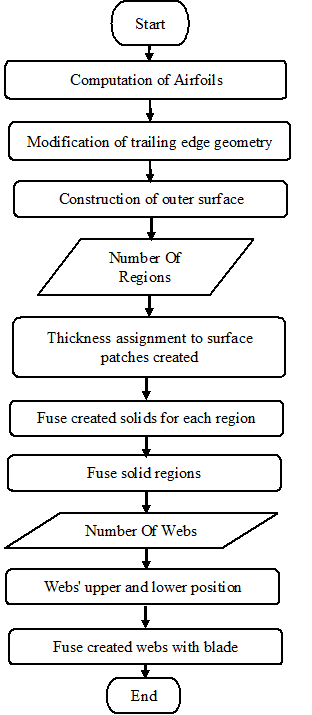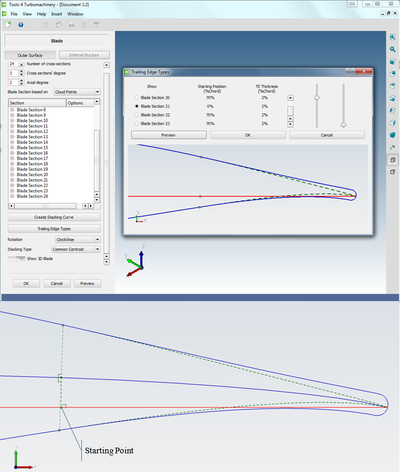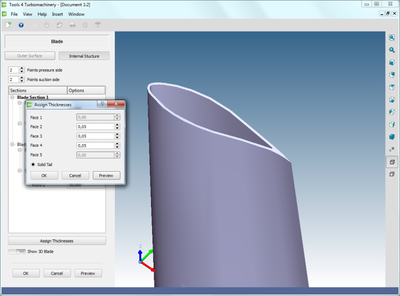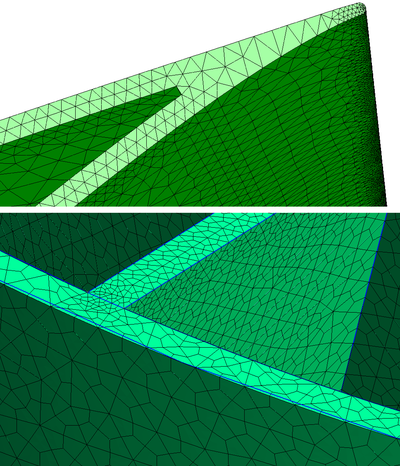A software tool named T4T (Tools for Turbomachines) has been developed for the parametric design of turbomachinery and wind turbine blades by members of the Turbomachines & Fluid Dynamics Laboratory (TurboLab-TUC). The complete design procedure is object-oriented and parametric, providing the ability to the user to define various types of blades. It has been developed in QT C++, utilizing OpenCascade graphical and computational libraries. The software allows the user to design the outer surface either by specifying some physical parameters for each blade section, or by directly interpolating a surface through a cloud of points. The current version of T4T software, introducing the definition of internal blade structure for wind turbines rotors, is fully parametric and customizable, allowing the user for defining the internal blade structure, including shear webs. The computational procedure finally produces compound solids, which can be further imported to mesh generation and analysis software through standard geometry exchange protocols, for cooperation with CFD and CSD solvers.
More specifically, the additional functions and modifications of the outer surface module are the following:
- The ability to modify trailing edge geometry and add thickness to the trailing edge.
- The methodology for the computation of (a) the mean camber line (for an arbitrary blade section), (b) its leading edge, and (c) its chord.
- The modification of the lofting procedure, for the proper adaptation of the surface at the leading and trailing edges.
- The ability to manipulate airfoils with different number of points for the blade construction.
- The ability to create custom stacking lines at custom positions.
Concerning the blade's internal structure definition, the blade is divided into regions that are used to assign different laminate thicknesses and materials. This is accomplished by defining the desirable surface patches as percentages of blade’s radius and blade’s section chord at selected positions. In each blade patch, the thickness of the laminated material can be parametrically defined; the location of each shear web is also prescribed, by utilizing user-defined parameters, while the profile of the web is produced as a sweep surface. T4T has the ability to create compound solids, which can be used for Finite Element Analyses; this is feature not common between other similar software.
T4T provides an intuitive user-interface for defining the outer and inner blade geometry, while highly detailed 2D and especially 3D views of the produced blades are provided to the user during the whole blade design process. The completely parametric definition of all produced geometries allows for the automatic cooperation with optimization methodologies, as the whole procedure can be performed in a batch mode without the need of the graphical interface, by importing the design parameters from appropriate text input files. The final geometry is exported in standard STEP format.
References:
G.N. Koini, S.S. Sarakinos, I.K. Nikolos, "Parametric Design for Turbomachinery Blades", CD Proceedings of the ΙΕΕΕ-EUROCON 2005, Belgrade, November 22 – 24, 2005, pp. 539-542 (IEEE Catalog no.: 05EX1255C, ISBN: 1-4244-0050-3).
G.N. Koini, S.S. Sarakinos, I.K. Nikolos, "A Software Tool for Parametric Design of Turbomachinery Blades", Advances in Engineering Software, 40(1), pp. 41-51, 2009. https://doi.org/10.1016/j.advengsoft.2008.03.008
G.N. Koini, I.K. Nikolos, "Design of turbomachinery bladings using "T4T"", Proceedings of the 7th GRACM International Congress on Computational Mechanics, Athens, June 30 - July 2, 2011.
G. Strofylas, I.K. Nikolos, "Wind turbine blade design using T4T", Proceedings of the 10th HSTAM International Congress on Mechanics, Chania, Crete, Greece, 25-27 May, 2013.
G.A. Strofylas, G.I. Mazanakis, I.K. Nikolos, "Wind turbine blade structure parameterization using T4T", Proceedings of the ASME 2014 International Mechanical Engineering Conference & Exposition, IMECE2014, Nov. 14-20, Montreal, Quebec, Canada, Paper No. IMECE2014-39674. https://doi.org/10.1115/IMECE2014-39674
Numerical Applications and Simulations













